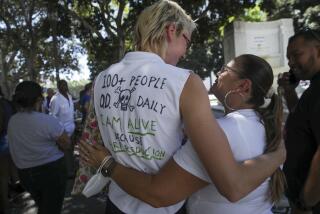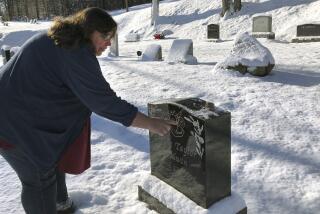Cancer deaths drop for 2nd year
- Share via
A second straight year of declining cancer deaths announced Wednesday marks the beginning of what is expected to be a long-term drop as the success of anti-smoking campaigns launched decades ago accelerates progress against the biggest cancer killer -- lung cancer.
The American Cancer Society reported that cancer deaths in 2004 dropped by 3,014 -- nearly eight times the number during the previous year -- driven by sharp declines in colorectal cancer fatalities, which totaled 53,380 in 2004.
But the biggest declines in the coming years are expected to be in tobacco-driven tumors in women. Lung cancer kills about 160,000 men and women in the U.S. each year.
Previous drops in cancer death rates have been fueled by steep declines in smoking among men, but women have lagged nearly two decades behind them in heeding the call to quit.
Lung cancer rates among women have begun to plateau and are expected to begin falling soon, mirroring the pattern observed in men 15 years ago.
“What we are seeing now is the peak of the lung cancer epidemic in women,” said epidemiologist Elizabeth Ward, one of the authors of the new report. “We would anticipate that deaths would start heading down.”
The improvements in battling this once uniformly lethal disease are expected to be augmented by declines in other cancers as screening and treatment are extended to underserved populations.
“President Nixon declared ‘war’ on cancer in the 1970s, and we are finally beginning to see some of the fruits,” said Dr. Robert Figlin of the City of Hope Comprehensive Cancer Center in Duarte.
But experts caution that the growing incidence of obesity and declines in physical activity threaten to reverse many of the hard-won gains.
In addition, doctors warn that access to cancer care also needs to be improved. “For all cancers, African American men have a 38% higher death rate than Caucasians, and African American women have an 18% higher rate,” said Dr. Christy Russell, an oncologist at USC/Norris Cancer Hospital. “I find those statistics sobering.”
Next to heart disease, cancer is the leading cause of death in the U.S. with 553,888 deaths in 2004, according to information from death certificates compiled by the National Center for Health Statistics. An estimated 1,444,000 cancers were diagnosed that year.
Last year, the cancer society announced the first drop in cancer deaths in more than 70 years. But the small size of the 2003 decline -- 369 deaths -- led many to question its significance.
“This second consecutive drop ... much steeper than the first, shows last year’s historic drop was no fluke,” said John R. Seffrin, the society’s chief executive. Cancer death rates have actually been declining for 13 years, but the lowered rate has been overwhelmed by growth of the population, leading to an increase in the absolute number of deaths, he said.
Improvements in prevention, screening and treatment “have now overtaken trends in aging and growth of the U.S. population, resulting in decreased numbers of deaths,” Seffrin said.
“Even in the face of an aging population, we are seeing a dramatic decrease,” added Dr. Glen R. Justice, medical director of Orange Coast Memorial Medical Center in Fountain Valley.
Death rates from all cancers peaked for men in 1990 and for women in 1991, then began dropping at a rate of about 1% per year. In 2003 and 2004, the rate doubled to 2% per year.
The initial declines were attributed largely to a drop in smoking among men, which peaked in the 1960s. The declines were accelerated by increased testing for colorectal, prostate and breast tumors and by more aggressive therapy for many of those cancers.
Where oncologists once simply removed a tumor surgically, they are now more likely to follow surgery with radiation or chemotherapy to reduce the chances of recurrence, experts said.
The latest drop in cancer deaths occurred across all four major cancer types -- lung, colorectal, prostate and breast -- although lung cancer deaths in women stayed relatively constant.
The biggest decline was in colorectal cancer, where mortality dropped 5.7% from 2003. Ward attributed the decline largely to increased screening for polyps, which are precursors of colorectal tumors, although lowered smoking contributed to it.
Colorectal cancer is highly curable if it is caught early and regular colonoscopies are becoming more common for people over the age of 50, she said.
But there is room for improvement, said lead author and epidemiologist Ahmedin Jemal. He said half of all people over age 50 had never had a colonoscopy.
The rate of breast cancer, which accounts for one in every four cancer cases in women and killed 40,954 in 2004, has been declining due to increased mammography and more aggressive therapy, said Russell of USC/Norris Cancer Hospital.
Projections indicate that by 2015, the number of deaths from the disease will have dropped to half of what they were in 1991, she said.
Deaths could fall even further because of the recent drop in hormone replacement therapy. Researchers last month reported at a medical meeting in Texas a sharp decline in breast cancer incidence that they attributed to decreased use of the therapy, and experts predict a corresponding decline in mortality several years down the road.
The death rate from prostate cancer, which accounts for 29% of cancer deaths among men and killed 29,002 in 2004, is also dropping. “We have a test that is detecting a lot of cancer at an early stage, and we have effective treatments for prostate cancer,” Ward said.
While the war is being won on some fronts, ground is being lost on others, experts cautioned. Obesity and the lack of physical activity are thought to be linked to a third of all cancers, about the same proportion as smoking.
Being overweight not only increases the risk of many cancers -- especially breast, prostate, ovarian and colorectal -- it also decreases the chances of surviving cancer that is already established, according to Dr. Patricia A. Ganz of UCLA’s Jonsson Comprehensive Cancer Center.
*
denise.gellene@latimes.com
*
Begin text of infobox
Detecting disease
American Cancer Society screening recommendations for people of average risk.
Breast cancer: A mammogram every year for women starting at age 40. A clinical breast exam about every three years for women in their 20s and 30s and every year for women 40 and over.
Colorectal: Regular screening should begin at age 50. The options include a fecal occult blood test, a flexible sigmoidoscopy and a colonoscopy.
Prostate: A PSA blood test and digital rectal examination annually beginning at age 50. African American men should begin testing at age 45.
Lung: No recommended screening procedures.
Further information is available online at www.cancer.org.
*
Source: American Cancer Society






